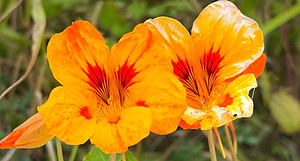
Óbidos
More of Day 5: April 29
The bus rides on the Heart of Portugal tour are not long. The whole country is about the size of the State of Indiana. This afternoon we had our longest bus ride of the tour, the three hours it took to get from the Rovisco Garcia farm to Óbidos. I'll bet we passed through some beautiful countryside. Gary and I wouldn't know because we were in a food and wine coma! I'm pretty sure that almost everyone else napped for much of the bus ride, too!
So our batteries were re-charged when we arrived in Óbidos. I liked the first glimpses of our hotel, the Hotel Real D'Óbidos. The building was constructed in the 14th Century and served as the residence of noblemen for centuries. Today it's a medieval-themed (think swords, shields, suits of armor, tapestries), boutique-sized hotel of 18 rooms, spacious rooms named after Portuguese kings, containing four-poster, canopied and curtained beds. Although our group didn't need all 18 of the rooms, the hotel had made the decision to let us have the whole place to ourselves. This was going to be a superb place to stay for two nights, just like occupying our own manor house. It had a big, comfy-looking lounge with a large stone fireplace, a bookcase bar (the person manning the desk would make a drink for anyone who asked), and multiple outdoor terraces, including one on the rooftop with an inviting swimming pool. Later there would be time to relax here like nobles. Right now, Claúdia was leading us on an orientation walk around town.
Our stroll through Óbidos was slow-paced. The town doesn't have blockbuster tourist sites to visit. It's just a very picturesque, charming medieval village containing narrow cobbled streets lined with whitewashed buildings trimmed in royal blue and gold. Those buildings house small restaurants, bars, boutiques, shops and art galleries. The town of course has some churches and squares. We saw pretty flowers everywhere, and caught the lovely scent of citrus trees.
The awesome site in town is Óbidos Castle! Not for a tour of the interior. It now houses a hotel. But the exterior view is great! The castle was built by the Moors in the 8th century but there were many reconstructions in the medieval period. The castle's ramparts encircle the whole town. The name Óbidos actually means "walled city." You can walk on top of the ramparts and Claúdia suggested it as a worthwhile way to spend some of our free time in Óbidos. We'd get high-up views of the whole village center inside the wall and the vineyards and rolling hills that surround the town. She did caution that walking on the wall might not be everyone's cup of tea, as the path is narrow in spots, is without railings, and the stone stairs leading up to the wall can be slippery and even loose. As Claúdia added these warnings, I could see some in our group mentally crossing the rampart-walk off of their list of things to do, while the description seemed only to buoy the enthusiasm of some others!

















If the street scenes above give the impression that Óbidos is a sleepy little town undiscovered by tourists, let me be transparent. These photos were taken in the very late afternoon and early evening. During the day tomorrow these streets would be relatively crowded! When you visit a small European town whose charm has become widely known, do yourself a favor and schedule it as an overnight stay. Soak up the vitality of the street life during the day, accepting that you're not the only one who wants to experience the magic of this place. Put your camera away and just enjoy the festivity. Then when the day trippers leave, help yourself to a seat in the outdoor area of your chosen restaurant. Sit back and relax and have a leisurely meal, guilt-free over how long you linger since there is no longer a line of people waiting to be seated. That evening and the next morning, stroll the much-emptier streets and take photos that might just fool your friends back home into thinking that you discovered a quaint, special place that no one else seems to know about!

It's 8 a.m. somewhere!
Dinner was on our own this evening. Wandering through town with our tour buddies Anne and Mark, looking for a place to catch a light meal, we passed many small ginjinha bars. We'd seen ginjinha bars scattered throughout Lisbon's neighborhoods and had learned that it's a sweet liqueur made from sour cherries, served in a shot glass or sometimes in a little chocolate cup, often with an alcohol-infused cherry in the bottom. The Portuguese love ginjinha! Ginjinha bars open early in the morning for those who like to toss down their daily dose right away, surely a cure for whatever might be ailing them. There usually are no tables in a ginjinha bar, the customers just stand. Here in Óbidos, most ginjinha bars had a window counter on the street. They're proud of their ginjinha in this town, as it's made with an extra sour cherry that is local to this region.





I loved the location of our hotel, just outside the walled center village. This was the night view from the window of our room. The hotel's costumed staff and medieval decor might seem a little theme-park'ish to some but I really liked it! It put me in a fun frame of mind for our stay in this delightful medieval village!